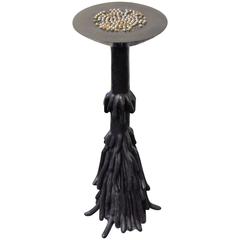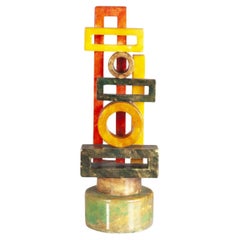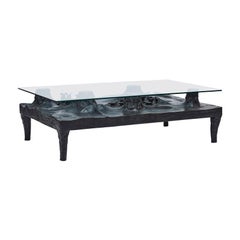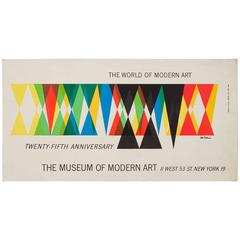Leo Lionni Furniture
1
1
1
1
1
1
1
1
1
1
1
1
1
5,206
4,014
2,460
2,235
Creator: Leo Lionni
Leo Lionni Original No. 1 of 6 Sculpture the "Giraluna" from Parallel Botany
By Leo Lionni
Located in Middlesex, NJ
The giraluna is a spectral plant entity from Leo Lionni's Classic alternate universe textbook Parallel Botany.
About the Sculpture:
The Giraluna
This elusive and capricious plant is the Dream Queen of parallel botany. Hydendorp, quite rightly, does not hesitate to define it as the "most parallel of plants, most plantlike of the parallels," and in so doing he stresses not so much its physiognomic oddnesses as the disconcerting normality of its shape. "If we were in the jungle," he writes, "and we found one blocking our way, we would not for an instant hesitate to hack it down with our machetes."1
But it will not be our good fortune to encounter it. If in reconstructions the Giraluna displays considerable plantness of form and an exact and convincing solidity, in its natural environment it can be perceived only as a nebulous interplay of glimmerings and empty spaces which alternate in the darkness and vaguely suggest where its outlines might be. (pl. XXIV) Its nocturnal presence, in fact, is manifested almost entirely in terms of the equivocal O'-factor of the moonbeams, which was discovered and measured a few years ago by Dennis Dobkin of the Point Paradise Observatory. This factor changes the light-shade ratio which normally defines volumes into a subtle interplay of lucencies and opacities, so that our perceptions, our basic sensorial habits conditioned by thousands of years of daytime life in the "solar key," would need complete readjustment and indeed reversal in order to come to terms with it. Daylight isolates objects, bestowing a noisy Meaning on all the odds and ends in the world. But night takes everything away except the very soul of things: a black light, a transparent darkness, a secret we cannot grasp.
During the long night of the Erocene era man caught a glimpse of the Giraluna rising mysteriously in its barren landscape. Presolar man imagined himself the child of the Moon. In her lap he had known the comfort of the life, silent torpor of the night, and by her light he had seen silver pearls lie weightlessly upon the coronas of the first great flowers. But he left us only a few enigmatic signs of all this: the Feisenburg cave, the petrified bones in the Ahmenstadt tumulus, the Boergen Cup. Paradoxically enough, all that we do in fact know of his presence in that landscape comes to us from our study of his nocturnal vegetation,
Around the middle of the Erocene era, when the flowers of night were fading away in the light of a new dawn, man saw that outlines and colors were slowly hardening. Thus he discovered the stone-hard world of day, and learned to be the child of both Sun and Moon, of Amnes and Ra, of Disarm and Karak, of Nemsa and Taor. The "crawling stones" of Yorkshire, the stele of Tapur, the graffiti of Klagenstadt, these have preserved for us the nearly obliterated images of the two divinities who from the center of their temples drew the design of the universe.
But the Sun was not long in attaining absolute power over everything in the world. "O Ra, o Amno Ra our benefactor, glowing and flaming! Gods and men bow down before you, for you are their creator and their only Lord." Such was the prayer of Amresh, High Priest of Egypt. And a new vegetation, outspoken and exuberant, appeared on the earth, and made the bright leaves dance in the morning breeze. Night soon became no more than a dark corridor joining one day to another, a place of visions and memories, a storehouse of words and images. It became a secret refuge where the vanished flowers could once more flaunt their coronas to the Moon. And thousands of years later the black flowers of that distant night-Giraluna, Lunaspora, Solea argentea-were born from seeds hidden deep in a soil rich with legends and stories.
If our knowledge of the Giraluna is today reasonably complete and detailed this is due to the industry and scholarship of Professor Johannes Hydendorp of the University of Honingen, who has collected and collated all known facts and kept his records abreast of the latest developments. Our historical and geographical information comes from the most varied sources: legends and folk tales handed down from generation to generation, accounts given by explorers, anthropologists, and paleontologists, and of course the more recent testimony of botanists such as Heinz Hornemann and Pierre Maessens.
Source: Sivatherium. narod .edu
About Sculpture:
Leo Lionni is best known today for his children's books: Little Blue and Little Yellow; Frederick—the one about the mouse who gathers poems while his family is harvesting seeds for the winter—Swimmy the Fish. Of course the children don't remember his name, but to parents and grandparents, the ones who actually do the reading, he is something of a celebrity. Most people don't realize that Lionni is also one of the 20th-century's most influential graphic designers. Within that field, he is a legend. In fact, he didn't start doing children's books until he had left the world of advertising, teaching, and design to allow more time for contemplation and for art. Little Blue and Little Yellow (1959) began as an improvised entertainment for bored grandchildren. What can you do with a few scraps of colored paper and a lot of imagination ? Make the first best-selling children's book illustrated with abstract art. Before that his work as design director for Olivetti Corporation of America and the art director of Fortune magazine, the co-founder of the Aspen...
Category
20th Century American Mid-Century Modern Leo Lionni Furniture
Materials
Steel, Bronze
Related Items
Female Sculpture in Bronze from the Neapolitan School
Located in bari, IT
La Paesana bronze statuette Neapolitan school, early 1900.
Category
Early 1900s Italian Other Antique Leo Lionni Furniture
Materials
Bronze
Modern Totem marble sculpture from the 1970s
Located in bari, IT
The Modern Totem " In Equilibrio Precario" sculpture made of different shapes of marble and colors created by a missed artist in the 1970s.
Category
1970s Italian Mid-Century Modern Vintage Leo Lionni Furniture
Materials
Marble
Decorative African Antelope Sculpture from the Tribal People of Benin
By People from Benin
Located in Miami, FL
Intricately hand-crafted African antelope, Benin tribal sculpture.
Details in hand-hammered bronze on wood small pieces attached with small nails and numerous carvings.
This object form is one of the best-known examples of Benin art, created from the thirteenth century onwards, by the Edo people, which also included other sculptures in brass, including some famous portrait heads and smaller pieces of art.
Cast bronze.
Tribal African Art...
Category
20th Century Beninese Tribal Leo Lionni Furniture
Materials
Bronze
Bronze Sculpture of a Female Nude by Michele Zappino from the 1990s
Located in Milano, MI
Sculpture of a reclining female nude in bronze and wooden base, created by Michele Zappino in the 1990s
Ø 49 cm Ø 20 cm h 14 cm
Category
1990s Italian Mid-Century Modern Leo Lionni Furniture
Materials
Bronze
Italian crucifix Brutalist Sculpture from the 1960s
Located in bari, IT
Italian brass brutalist sculpture from the 1960s depicting a stylized crucifix.
Category
1960s Italian Brutalist Vintage Leo Lionni Furniture
Materials
Brass
Sculptures of Larges Cats Italian Ceramic from the 1970s Set of 2
Located in Auribeau sur Siagne, FR
This is a vintage terracotta from Italy representing a seated Cat. You can see realism in the mouth the eyes and the teeth.
The colors are Brown white and blue. This sculpture has b...
Category
1970s Italian Rococo Revival Vintage Leo Lionni Furniture
Materials
Ceramic
Grand Sculpture of Zeus from the 19th Century
Located in Madrid, ES
This spectacular plaster sculpture, depicting the majestic face of Zeus, is a true gem from the 19th century. Crafted in Italy during this era, it captures the imposing presence and ...
Category
Late 19th Century Antique Leo Lionni Furniture
Materials
Plaster
No End Bronze Sculpture
Located in Paris, FR
Sculpture no end bronze
All in polished solid bronze.
Category
21st Century and Contemporary Belgian Leo Lionni Furniture
Materials
Bronze
“Revolve” No.S4 'made to order' – Contemporary Decorative Sculpture from Denmark
By Flensted Mouritzen
Located in Holte, DK
“Revolve” – No. S4.
This is made in a limited edition of only 5 pieces + 1 AP.
The five sculptures are made in five different colors, making them all truly one of a kind. The piece in the photo has been sold, but you can request your favorite color under customization. This would be made to order and numbered as No. 02/05.
The piece is made from plaster, fish glue, and pigments. It's waxed and weighs 1kg (2.2lb).
About Revolve:
The starting point of this project is rooted in Flensted Mouritzen's interest in old stucco materials and moulding techniques. It has grown into a fascination with the two-dimensional line of the running mould technique being transformed through a specifically created turning machine...
Category
2010s Danish Modern Leo Lionni Furniture
Materials
Cast Stone
H 7.09 in Dm 4.73 in
Original Hand Made Glass Sculpture, Signs of the Zodiac / Libra, 1960
By Zelezny Brod
Located in Praha, CZ
- Czechoslovakia around 1960s
- hand made sculpture in town Zelezny Brod
- one of the oldest Glass factorie worldwide like Murano
- Rj.
Category
1960s Mid-Century Modern Vintage Leo Lionni Furniture
Materials
Art Glass
The Wind, Original Marble Sculpture, 1920s
Located in Roma, IT
The Wind is an original marble sculpture made by Anonymous artist and realized in the 1920s.
A beautiful white marble sculpture representing a female portrait as the personificati...
Category
1920s Italian Vintage Leo Lionni Furniture
Materials
Marble
“Revolve” No.S2 'made to order' – Contemporary Plaster Sculpture from Denmark
By Flensted Mouritzen
Located in Holte, DK
“Revolve” – No. S2.
This is made in a limited edition of only 5 pieces + 1 AP.
The five sculptures are made in five different colors, making them ...
Category
2010s Danish Modern Leo Lionni Furniture
Materials
Cast Stone
Previously Available Items
Contemporary Bronze Coffee Table by Leo Lionni, a Unique Piece
By Leo Lionni
Located in London, GB
Bronze coffee table by Leo Lionni, with crystal glass top. Signed. A unique piece. The table depicts a pastoral scene with trees and flowers, some of which have a gilt bronze patination. A longer glass table...
Category
1990s Italian Post-Modern Leo Lionni Furniture
Materials
Bronze
25th Anniversary MoMA Poster by Leo Lionni
By Leo Lionni
Located in Brooklyn, NY
Archiving the younger years of New York’s very own Museum of Modern Art, this vibrant, vintage 25th Anniversary MoMA poster was designed by children’s illu...
Category
1950s American Mid-Century Modern Vintage Leo Lionni Furniture
Bronze Coffee Table by Leo Lionni
By Leo Lionni
Located in London, GB
Bronze coffee table by Leo Lionni, with crystal glass top. Signed. A unique piece.
Category
1990s Italian Post-Modern Leo Lionni Furniture
Leo Lionni furniture for sale on 1stDibs.
Leo Lionni furniture are available for sale on 1stDibs. These distinctive items are frequently made of steel and are designed with extraordinary care. There are many options to choose from in our collection of Leo Lionni furniture, although gold editions of this piece are particularly popular. Many of the original furniture by Leo Lionni were created in the mid-century modern style in united states during the 20th century. If you’re looking for additional options, many customers also consider furniture by David Segel, Naomi Feinberg, and Larry Mohr.




